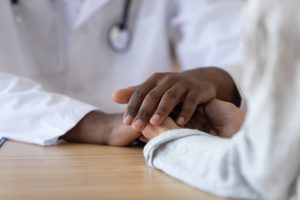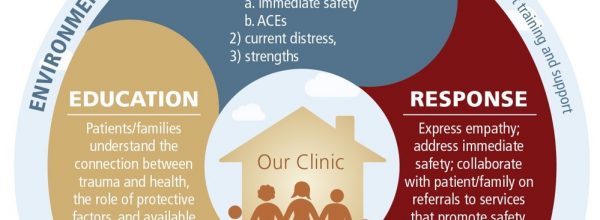
On September 22, the California ACEs Learning and Quality Improvement Collaborative (CALQIC) held its kick-off session for members on childhood trauma, screening, resilience, and healing.
Adverse childhood experiences (ACEs) are a public health crisis affecting 34.8 million children across the country, leaving them at higher risk for health, behavior and learning problems. Exposure to ACEs such as abuse, neglect and parental mental illness can affect everything from children’s brain development and immune systems to their DNA. A recent study estimated that health-related costs of ACEs to California alone were approximately $113 billion a year.
California Surgeon General Nadine Burke Harris, MD, who has called COVID-19 and trauma “a perfect storm” for the buildup of toxic stress, has led the drive to roll out universal ACEs screening in the state. “We have no other option but to tackle this issue head on — with early detection and evidence-based interventions, we can transform health outcomes,” said Burke Harris, a pediatrician whose book, TED talk, and organization she created to focus on healing the long-term effects of childhood adversity have made ACEs a household word in the state.
To address the persistent health problems linked to childhood trauma, including a higher risk of cancer, diabetes, heart disease, dementia, and suicide, the state created CALQIC as part of the California ACEs Aware intiative, a project of the Office of the California Surgeon General and the state Department of Healthcare Services. The initiative offers Medi-Cal providers training, clincal protocols, and payment for screening children and adults for ACEs. In addition to its work with CALQIC, the Center for Care Innovation (CCI) runs the Resilient Beginnings Network in partnership with Genentech Charitable Giving.
“This project is so exciting because it’s the largest coordinated dissemination of ACEs screening and response to date,” said UCSF professor Edward Machingter, MD, about the CALQIC program, led by the UCSF Center to Advance Trauma and Resilience-Informed HealthCare, in partnership with CCI, the RAND Corporation, and the Los Angeles County Healthcare Services. “It’s like we’re at the cutting edge of a new way of practicing medicine.”

Dr. Alicia Leiberman of UCSF
Renowned child psychologist, author and researcher Alicia Lieberman, PhD, who directs UCSF’s Child Trauma Research Program, expanded on this theme in her remarks.
“Traditionally, for thousands of years, healthcare providers defined themselves as taking care of the body, mind and soul,” Lieberman said. “I think that we now want to help restore that tradition by widening the lens of healthcare to move from a biology-based focus to a holistic model of care based on trust – one in which the provider and the patient work together to understand how the patient’s life experiences are affecting health and behavior, and how to use positive influences to improve wellbeing. Research, she said, suggests this “hope-oriented approach” increases satisfaction in the health care relationship.
Six key points about ACEs and health care
The working session also included talks from program directors and researchers working with CCI, the Department of Health Services of Los Angeles, the National Pediatric Practice Community on ACEs/Center for Youth Wellness, and UCSF Benioff Children’s Hospital (Oakland). Here are six of the main takeaways from the presentations about ACEs science and health care:
1. The link between childhood trauma and an increased risk of mental and physical illness in both childhood and later life is indisputable.
The 1998 landmark study on adverse childhood experiences (ACEs) such as abuse and neglect found they were associated an increased risk of life-threatening conditions, including cancer, heart disease, depression, and suicide; these findings have since been confirmed and expanded upon by dozens of other studies. “The data showing the impact of childhood trauma and adult physical and mental health is rock solid,” said Dr. Machtinger, in his opening remarks. “We also know from research and from emerging studies in primary care that understanding and addressing trauma can interrupt its impact on later illness and on death. And it can more effectively treat the many-trauma related conditions that we typically struggle with every day in clinic.”
2. Screening for trauma in primary care can improve health care.
Some clinicians in California and elsewhere have asked whether it’s necessary to add another childhood health screen to their already long list. “Perhaps the most succinct answer is that screening can improve health care when done in a spirit of compassion and care,” Lieberman said.
 This is because screening can detect adverse childhood experiences that may undermine both physical and mental health if unaddressed. Data shows that by age 16, more than two-thirds of children have experienced a traumatic event, and one in 10 children has experienced three or more ACEs. “This is a time where children’s brains are still developing, when their sense of self is being formed, and when the understanding of what relationships are about is being created,” Lieberman said. “Trauma imprints the brain with a sense of unpredictability and danger that cannot be overestimated. The brain is developed to respond to danger and to pain by freezing, fighting, or fleeing.” This can result in toxic stress, in which the body continues to sound an alarm long after the danger is past.
This is because screening can detect adverse childhood experiences that may undermine both physical and mental health if unaddressed. Data shows that by age 16, more than two-thirds of children have experienced a traumatic event, and one in 10 children has experienced three or more ACEs. “This is a time where children’s brains are still developing, when their sense of self is being formed, and when the understanding of what relationships are about is being created,” Lieberman said. “Trauma imprints the brain with a sense of unpredictability and danger that cannot be overestimated. The brain is developed to respond to danger and to pain by freezing, fighting, or fleeing.” This can result in toxic stress, in which the body continues to sound an alarm long after the danger is past.
“Traumatic childhood experiences can overwhelm our coping responses and make us respond with a persistent increase in stress hormones without a return to homeostasis, so that this chronic elevation becomes toxic,” said Lieberman. “We’re angry, depressed, anxious, and respond often either with aggression or with withdrawal or with a numbing of our sense of empathy toward ourselves and toward others. These experiences that first emerge in childhood last the rest of our lives. And yet there is always the opportunity to reframe these experiences and promote healthier responses”– including a more normative level of stress.
3. ACEs screening does not retraumatize patients.
Another worry some primary care providers have is that asking patients about their childhood trauma will force them to relive the worst moments of their lives and retraumatize them. Lieberman said research suggests the opposite.
 A wealth of studies, she pointed out, “have shown giving a name to difficult experiences and the feelings associated with them, which we call ‘speaking the unspeakable,’ helps patients regulate their physiology, the way they experience emotions linked to childhood trauma, and the way they express behaviors linked with those emotions” – as long as the screening is done with a holistic approach in which the providers create an environment that is calm, safe, empathic, and welcoming. As Lieberman noted, “We need to remember that stress lives in the body, and that being seen and heard by a trusted person actually promotes trust and offers relief.”
A wealth of studies, she pointed out, “have shown giving a name to difficult experiences and the feelings associated with them, which we call ‘speaking the unspeakable,’ helps patients regulate their physiology, the way they experience emotions linked to childhood trauma, and the way they express behaviors linked with those emotions” – as long as the screening is done with a holistic approach in which the providers create an environment that is calm, safe, empathic, and welcoming. As Lieberman noted, “We need to remember that stress lives in the body, and that being seen and heard by a trusted person actually promotes trust and offers relief.”
4. ACEs screening and treatment should be rooted in mutual respect, dignity, and consent.
“Trauma is unpredictable, uncontrollable, overwhelming,” said Lieberman. “It shatters expectations of safety and predictability, and it creates shame and guilt. That’s why ACEs screening alone is not enough.” She explained that ACEs screening needs to be rooted in mutual respect and trust, in which a provider builds a partnership with the patient based on family and individual strengths. “We tell the patient they can opt not to respond to questions, and we’re very clear that they decide what kind of help they want,” said Lieberman. “The patient is empowered by becoming a partner in the treatment plan. This approach affirms the patient’s dignity because it is done with consent.”
 In this approach, developed by CALQIC and known as the TRIADS Framework, providers respond to patients with empathy, address immediate safety, and collaborate with them on referrals that promote safety, connection, and healing. As Machtinger explains, “The TRIADS framework is designed to achieve the goals of mutual respect, dignity, and consent by not only screening for adversity, but also inquiring about the patient’s distress and strengths (that is, the trauma inquiry covers adversity, distress, and strengths). It is in this way that we can understand the individual in front of us and how we can best support them and their families. “Providers also educate patients on the connection between trauma and health and how that might show up, from childhood asthma attacks that don’t resolve with treatment to a higher risk of cancer, heart disease, depression, drug use or suicide attempts in later life. Finally, providers offer guidance on protective factors — including sleep, exercise, nutrition, nurturing relationships, mindfulness, and mental health — that promote resilience.
In this approach, developed by CALQIC and known as the TRIADS Framework, providers respond to patients with empathy, address immediate safety, and collaborate with them on referrals that promote safety, connection, and healing. As Machtinger explains, “The TRIADS framework is designed to achieve the goals of mutual respect, dignity, and consent by not only screening for adversity, but also inquiring about the patient’s distress and strengths (that is, the trauma inquiry covers adversity, distress, and strengths). It is in this way that we can understand the individual in front of us and how we can best support them and their families. “Providers also educate patients on the connection between trauma and health and how that might show up, from childhood asthma attacks that don’t resolve with treatment to a higher risk of cancer, heart disease, depression, drug use or suicide attempts in later life. Finally, providers offer guidance on protective factors — including sleep, exercise, nutrition, nurturing relationships, mindfulness, and mental health — that promote resilience.
5. All health care employees should receive training about ACEs and trauma-informed care.
“Everybody can be therapeutic without necessarily being a therapist,” Lieberman said. “And actually, sometimes the most humble people in an organization can create the most transformational care through their investment in the people that they connect to. One thing to remember is that often the clinic staff with the least organizational power are the ones who are asked to do their screening.” Many people assume front desk staff will hand out the screening forms and the doctor will provide the therapeutic support by interpreting the forms, “but I think it’s exactly the reverse,” she said. The person doing the screening – the first point of contact – “is the person that gives patients the message of how much the clinic cares.”
6. Self-care is crucial for providers doing trauma screening and treatment.
The backdrop to the ACEs screening rollout this year included political unrest, economic turmoil, a deadly pandemic, an inspiring movement for racial justice, and in California, raging wildfires and hazardous blankets of smoke, according to CCI program coordinator Nikki Navarette. “We know the work you do for CALQIC can be overwhelming as you deal with patient trauma in this midst of all this,” she said, urging providers to practice self-care and share their learnings with each other.
 Lieberman agreed self-care was essential. “We have to remember there are dangers to caring to you, as primary care providers on the front line,” said Lieberman. “You will hear and see [things] that can lead to burnout and vicarious traumatization. You are encountering challenges in your own daily lives while having to be responsive to your patients.
Lieberman agreed self-care was essential. “We have to remember there are dangers to caring to you, as primary care providers on the front line,” said Lieberman. “You will hear and see [things] that can lead to burnout and vicarious traumatization. You are encountering challenges in your own daily lives while having to be responsive to your patients.
“I think here, we need to remember that self-care is essential to remain effective,” she cautioned. “We need to practice what we teach our patients about cultivating time out, protecting our private life, seeking out consultation and support from our colleagues and building support systems at work. We also need to remember that there’s a crack in everything, and that mistakes can be repaired. That we are all learning together.”
Find this useful or interesting? We’re constantly sharing stuff like this. Sign up to receive our newsletter to stay in the loop.


